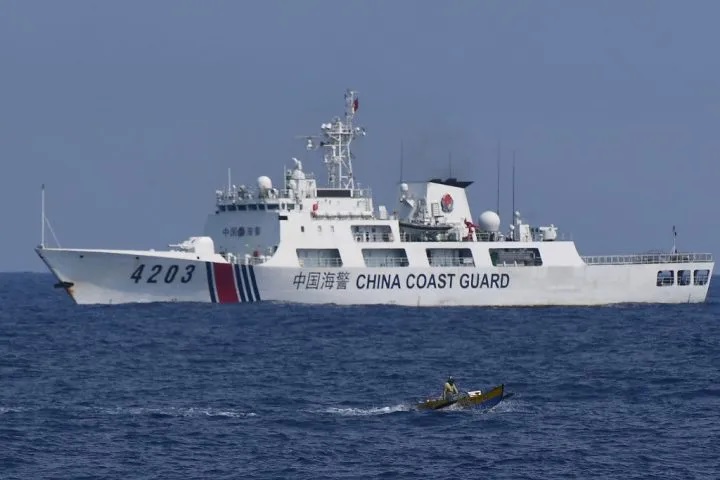The news was apparently big, but the announcement was strangely cautious. Earlier this month, China announced it had discovered the world’s first large-scale gas field in extremely deep waters and not far below the seabed. Lingshui 36-1 contains 680,000 tons of gas, said the China National Offshore Oil Corporation (CNOOC), and the data and plans for production had been approved by the “relevant government authorities.” It did not give a timetable or the exact location of the field – it described it only as “southeast of Hainan,” China’s southernmost island province.
It is easy to see why maritime borders are important for Vietnam
The reticence stems from the fact that the gas does not belong to China – at least not legally. It almost certainly lies in disputed waters near islands claimed by Vietnam, which was forcibly expelled from the territory by China in 1974. Beijing claims almost all of the South China Sea – an area of more than 3.2 million square kilometres, 13 times the size of Britain. Its claim is surrounded by a giant U-shaped line (the “nine-dash line”, as it is often called) that is compared to the tongue of a giant cow. Within this line, Beijing has asserted its “historic” claim with increasing aggression, militarising islands and intimidating rival claimants, which include the Philippines, Brunei, Malaysia and Taiwan.
The territorial expansion of imperial powers is usually associated with the advance of land-based armies, but China’s claim to sovereignty over such a vast area still represents a territorial aggression on a scale not seen since World War II. In 2015, Manila successfully challenged Beijing’s claims under the United Nations Convention on the Law of the Sea (UNCLOS), which both countries had ratified. China has not only ignored the ruling but has also used its coast guard, which is better equipped than most countries’ navies, to regularly harass rival ships exploring for oil and gas. So the CNOOC announcement this month will be a particularly bitter pill to swallow.
Vietnam, with which China also fought a brief border war in 1979, is militarily the strongest of the rival claimants. The coastal city of Da Nang is the closest Vietnamese city to the disputed Paracel Islands, a chain of 130 islands, rocks and reefs lying about 370 kilometers to the west. They have been heavily fortified since they were occupied by Beijing. The Lingshui 36-1 gas field is believed to be nearby. Further south are the Spratly Islands, to which Vietnam and China also make conflicting claims. Here, in 1988, Chinese soldiers mowed down dozens of Vietnamese soldiers standing knee-deep in water on Johnson South Reef – a gruesome video of this was filmed from a Chinese ship and is still widely circulating on the Internet.
I visited Da Nang while researching my new book, Vampire State: The Rise and Fall of the Chinese Economy. Vietnamese hostility toward China is deep-rooted and stretches back centuries. Da Nang was an ideal place to observe the recent twists and turns. Landing at the small airport, it was easy to spot the fighter jets in their fortified shelters, their noses protruding like crouched attack dogs. A three-story Paracel Island Museum sits on the water, overlooking the islands, and is crammed with documents supporting Hanoi’s claim. On a plinth outside the museum lies a salvaged fishing boat with an ugly crack in its side, which was rammed and sunk in 2020 by a far larger steel-hulled Chinese “fishing boat” – part of a Chinese naval militia. Da Nang also hosts a Paracel government-in-exile.
It is easy to see why maritime borders are important to Vietnam and why Hanoi feels particularly threatened by Beijing’s claims to all resources above, in and under the sea. Vietnam has a 3,000-kilometer coastline, around a third of the country’s population lives on the coast and half of the country’s GDP still comes from maritime activities.
Last year, a Chinese exploration ship and several coast guard vessels – possibly part of the operation that discovered the Lingshui 36-1 oil field – operated in Vietnam’s exclusive economic zone for several weeks, leaving only after rising tensions and repeated warnings from the Vietnamese government. In May 2014, China’s deployment of an oil rig in territory claimed by Hanoi led to a tense maritime standoff that sparked deadly anti-Chinese riots and arson attacks across Vietnam. The rioters attacked Chinese-owned factories and businesses in 22 provinces, leaving more than 20 dead and dozens injured. Beijing evacuated 3,000 of its citizens. Shortly after my visit, Vietnam banned the film’s release Barbie because of a scene in which the nine-dash line was apparently shown, such is the sensitivity.
Vietnam also responded to China’s creeping aggression by strengthening its ties with India, Japan and the US. A few days after my visit, the US nuclear-powered aircraft carrier USS Ronald Reagan visited Da Nang – a potent symbol of the changing power dynamics. Shortly after, President Joe Biden himself paid a state visit to the country and announced a “comprehensive strategic partnership” with America’s former enemy. In December last year, Chinese President XI Jinping visited Vietnam for the first time in six years (and Vietnam’s new Communist Party chief will be in Beijing next week).
These complex geopolitics may explain why the announcement of the Lingshui agreement was made with such restraint. Beijing has traditionally treated rival claimants in the South China Sea with barely concealed contempt – and largely still does so. It is more suspicious of Vietnam, which gave the People’s Liberation Army a bloody nose in the 1979 border war and rapidly modernised its own navy. But it is hard to imagine large-scale gas extraction in the disputed waters being viewed in Hanoi as anything other than the latest provocation by a country that generations of Vietnamese have come to view as an “invader from the north”.
This article originally appeared on The viewer‘s UK website.

